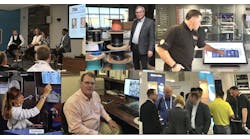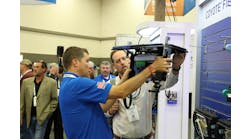Latest from Professional Development/Leadership
7 Facts About the STEM Workforce
Employment in science, technology, engineering and math (STEM) occupations has grown 79% since 1990, from 9.7 million to 17.3 million, outpacing overall US job growth. There’s no single standard for which jobs count as STEM, and this may contribute to a number of misperceptions about who works in STEM, and the difference that having a STEM-related degree can make in workers’ pocketbooks.
A new Pew Research Center analysis of U.S. Census Bureau data takes a broad-based look at the STEM workforce from 1990 to 2016 based on an analysis of adults ages 25 and older working in any of 74 occupations. These include computer, math, engineering and architecture occupations, physical scientists, life scientists and health-related occupations such as health care practitioners and technicians, but not health care support workers such as nursing aides and medical assistants.
7 Facts About STEM Workforce and STEM Training
1. STEM workers enjoy a pay advantage compared with non-STEM workers with similar levels of education.
Among those with some college education, the typical full-time, year-round STEM worker earns $54,745 while a similarly educated non-STEM worker earns $40,505, or 26% less.
And among those with the highest levels of education, STEM workers out-earn their non-STEM counterparts by a similar margin. Non-STEM workers with a master’s degree typically earn 26% less than STEM workers with similar education. The median earnings of non-STEM workers with a professional or doctoral degree trail their STEM counterparts by 24%.
2. While STEM workers tend to be highly educated, roughly a third have not completed a bachelor’s or higher-level degree.
A substantial share (35%) of the STEM workforce does not have a bachelor’s degree. Overall, about three-in-ten STEM workers report having completed an associate degree (15%) or have some college education but no degree (14%). These workers are more prevalent among health care practitioners and technicians, computer workers and engineers.
Some 36% of STEM workers have a bachelor’s degree but no graduate degree. Roughly three-in-ten STEM workers (29%) have earned a master’s, doctorate or professional degree. Life scientists are the most highly educated among STEM workers, with 54%, on average, having an advanced degree.
3. About half of workers with college training in a STEM field are working in a non-STEM job.
Among workers ages 25 and older with at least a bachelor’s degree, one-in-three (33%) have an undergraduate degree in a STEM field of study. But only about half (52%) of these STEM-trained workers are employed in a STEM occupation.
Among non-STEM occupations, management, business and finance jobs attract a substantial share of college graduates with STEM training (17%), particularly those who majored in engineering. Roughly a quarter (24%) of engineering majors are in a managerial, business or finance job.
Overall, among adults with a STEM college major, women are more likely than men to work in a STEM occupation (56% vs. 49%). This difference is driven mainly by college graduates with a health professions major (such as nursing or pharmacy), most of whom are women.
But, 38% of women and 53% of men with a college major in computers or computer science are employed in a computer occupation. And women with a college degree in engineering are less likely than men who majored in these fields to be working in an engineering job (24% vs. 30%). These differences in retention within a field of study for women in computer and engineering occupations are in keeping with other studies showing a "leaky pipeline" for women in STEM.
4. STEM training in college is associated with higher earnings, whether working in a STEM occupation or not.
Among college-educated workers employed full-time year-round, the median earnings for those who have a STEM college major are $81,011, compared with $60,828 for other college majors.
The earnings advantage for those with a college major in a STEM field extends to workers outside of STEM occupations. Among all non-STEM workers, those who have a STEM college degree earn, on average, about $71,000; workers with a non-STEM degree working outside of STEM earn roughly $11,000 less annually.
5. The share of women varies widely across STEM job types.
Women are underrepresented in some STEM job clusters, but in others they match or exceed their share in the U.S. workforce overall.
In fact, women comprise three-quarters of health care practitioners and technicians, the largest occupational cluster classified as STEM in this analysis, with 9.0 million workers – 6.7 million of whom are women.
And women’s gains since 1990 in the life sciences (up from 34% to 47%) have brought them roughly on par with their share in the total workforce (47%), a milestone reached in math occupations (46%) as well.
Women remain underrepresented in engineering (14%), computer (25%) and physical science (39%) occupations.
6. Women have made significant gains in life and physical sciences, but in other areas their shares have been stable and in computer jobs it has declined.
While there has been significant progress for women’s representation in the life and physical sciences since 1990, the share of women has been roughly stable in several other STEM job clusters.
In engineering, the job cluster in which women have the lowest levels of representation on average, women’s shares have inched up only slightly, from 12% in 1990 to 14% today.
And, the share of women has actually decreased in one of the highest-paying and fastest-growing STEM clusters – computer occupations. In 1990, 32% of workers in computer occupations were women; today women’s share has dropped to 25%.
7. Blacks and Hispanics are underrepresented in the STEM workforce.
Overall, blacks and Hispanics are underrepresented in the STEM workforce relative to their shares in the U.S. workforce as a whole. This underrepresentation is evident across all STEM job clusters, with one exception: 11% of health care practitioners and technicians are black, similar to the share of blacks in the total workforce.
Within job clusters, however, the share of blacks and Hispanics varies widely. For example, 37% of licensed practical and licensed vocational nurses are either black or Hispanic. By comparison, other health-related jobs have smaller shares of workers who are black or Hispanic, including physicians and surgeons (11%), pharmacists (10%), dentists (9%) and physical therapists (9%). Just 5% of optometrists, veterinarians and chiropractors are black or Hispanic.
Asians are overrepresented across all STEM occupational groups, particularly among computer workers and life scientists. They account for 19% of workers in both of these fields, which is much higher than their share in the workforce overall (6%).
The share of Asians varies substantially within occupational groups, however. For example, in engineering jobs the share of Asians ranges from 30% among computer hardware engineers to 2% among surveying and mapping technicians. Among health care practitioners and technicians, about one-in-five (21%) physicians and surgeons are Asian. But Asians comprise a far smaller share in other occupations, such as veterinarians (3%) and emergency medical technicians and paramedics (2%).
For more information, please visit:
http://www.pewsocialtrends.org/2018/01/09/diversity-in-the-stem-workforce-varies-widely-across-jobs/
https://usa.ipums.org/usa-action/variables/OCC2010#description_section
For more information, please see the online reports for the various charts and graphs illustrating these findings at https://www.pewresearch.org/fact-tank/2018/01/09/7-facts-about-the-stem-workforce/?utm_source=Pew+Research+Center&utm_campaign=af1a7f5267-EMAIL_CAMPAIGN_2018_01_09_Internet&utm_medium=email&utm_term=0_3e953b9b70-af1a7f5267-399449197.
About the Authors
Nikki Graf is a research associate focusing on social and demographic trends at Pew Research Center.
Richard Fry is a senior researcher focusing on economics and education at Pew Research Center.
Cary Funk is director of science and society research at Pew Research Center.
For more information, please visit https://www.pewresearch.org.




